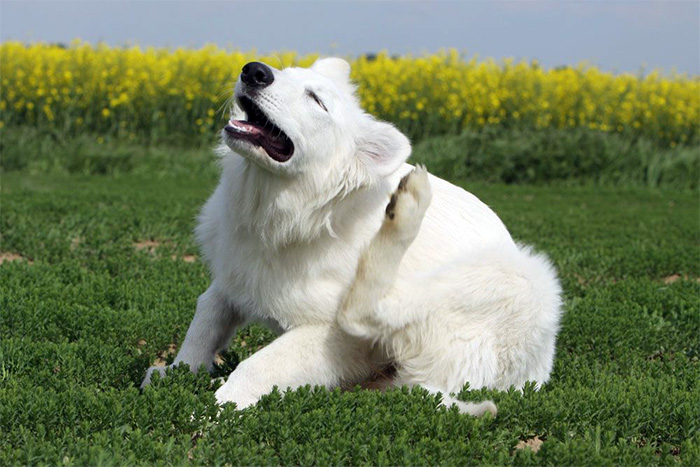Dogs are just as susceptible to skin infections and injuries as humans. But unlike their owners, canines cannot tell their humans about the onset as well as the severity, frequency and duration of their symptoms. Owners and veterinarians must then work together to determine the what, when, how and why of the symptoms related to the dogs’ skin issues.
So when your dog has one of the following common skin issues, you are well-advised to take note of important things that can provide veterinarians with useful information. Your information can contribute toward a definitive diagnosis and effective treatment plan for your pooch.
Pests in the Skin
The most common cause behind canine skin issues are pests including:
- Fleas are tiny insects that are not immediately visible to the naked eye but their presence is usually manifested via their eggs and droppings on your dog’s coat. Symptoms also include hot spots, excessive scratching or licking, and scabs. Complications of untreated flea infestation are blood loss and anemia, even exposed risks for parasite (tapeworm) infestation.
- Ticks are external parasites feeding on the blood of your pet. These should be properly removed from your dog’s skin so that their heads do not remain lodged in the skin. Complications from uncontrolled tick infestation are similar to flea infestation.
- Mites, which are tiny parasites, cause mange with symptoms like red skin, severe itching, hair loss, and sores usually on the ears, face and legs. Treatment will depend on the type of mange – sarcoptic or demodectic mange.
Fortunately, infestations of fleas, ticks and mites can be treated with several types of products coupled with home care methods. Your dog’s veterinarian will usually recommend pest control products, which can be purchased from online shops like Petsmart.
You should also be more vigilant about regular pet grooming so as to detect a new round of infestation before it becomes worse. Keep in mind that the healthier your dog’s skin and coat are, the lesser risk these tiny pests can take hold.
Bacterial Infections
Dogs are also at risk from bacterial infections especially when these animals have weaker immune systems, as is the case in puppies and elderly dogs. The good news: Veterinarians usually have an array of antibiotics for the effective treatment of these bacterial infections.
- Folliculitis is a bacterial infection that often occurs alongside other skin problems like allergies and mange. Its symptoms include bumps, sores and scabs in the skin among short-haired dogs as well as shedding of hair and scaly skin coupled with a dull coat among long-haired dogs. Treatment includes antibacterial ointments, shampoos, and oral antibiotics.
- Impetigo is a common bacterial infection in puppies. Symptoms include pus-filled blisters that typically develop on the abdomen’s hairless part. Treatment includes a topical solution for mild to moderate cases while oral antibiotics will be required for severe or persistent cases.
Always follow the vet’s prescription about oral antibiotics use and avoid providing medications for your dog without its vet’s approval. Otherwise, you may be making things worse for your beloved dog.
Fungal Infections
Yet another category of common canine skin issues are fungal infections, which also require appropriate veterinary attention.
- Yeast infections are characterized by intense scratching, licking or chewing, and irritated or discolored skin on the affected areas, usually on the paws or ears. Treatment includes topical creams, oral drugs, and medicated baths depending on the severity of the infection.
- Ringworm is a fungal infection, not an infection caused by a worm. Its primary symptom is a ring-like pattern on the affected area, often a dog’s head, ears, paws, and forelegs, coupled with scaly patches, inflammation, and hair loss surrounding the lesions. Anti-fungal medications are the best treatment options, which should be coupled with proper grooming as ringworm infections can spread quickly among dogs.
As with bacterial infections, you should apply the topical ointments or administer the oral medications to your dogs according to the vet’s instructions. Otherwise, the fungal infections will recur, which will not only increase the costs of treatment but prolong your pet’s suffering.
Other Skin Issues
Dogs are also vulnerable to other types of skin issues including:
- Allergic dermatitis, which can be caused by food, grooming products, and environmental irritants including insect bites and pollen. Avoidance of the allergens and corticosteroids are recommended.
- Alopecia, or shedding of hair resulting to moderate to severe hair loss, which can be caused by poor nutrition, illness, or stress.
- Acral lick granuloma, which is characterized by compulsive licking of a single area like the lower leg’s front part. Due to the constant licking, the area cannot be healed and the symptoms worsen, such as pain. Treatment includes the use of an Elizabethan collar or the application of a bad-tasting topical solution on the affected area.
- Skin tumors are hard lumps on the skin. Be sure to have these lumps checked by a veterinarian for proper diagnosis and treatment.
While many of these skin issues hounding dogs are not emergencies, it is always best to see a vet before the symptoms become worse or the underlying condition becomes untreatable.


